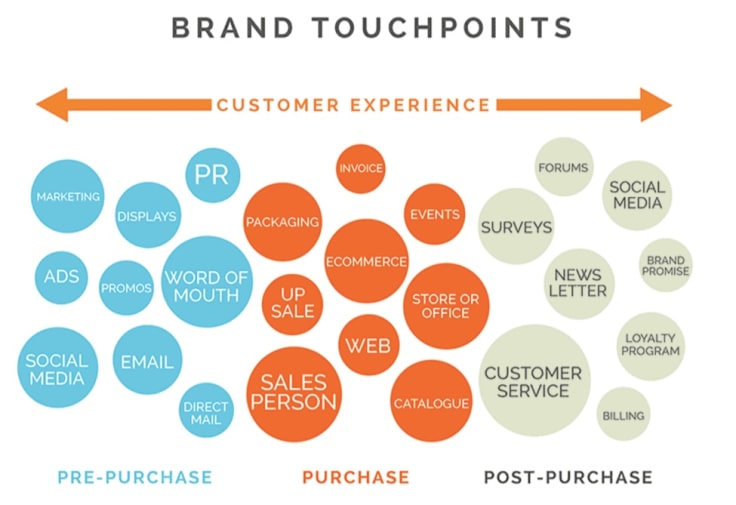Showing top 0 results 0 results found
Showing top 0 results 0 results found

Leveraging your marketing and customer service team's shared passion for customer experience has been a goal of most companies in the first quarter of 2018 - the year Forrester calls a year of reckoning for CX. But individual companies are still struggling to de-silo their customer experience offering across marketing and customer service teams (and that means a lot of valuable customer insights aren't being shared).
In the age of new social algorithms, growing disintermediation risk from Amazon and Google, and tightened budgets, bringing valuable CX insights to the table to create powerful and effective marketing strategies can be the missing ingredient in your marketing team's recipe for success.
Knowing your customer is Marketing Strategy 101. But recently, trendsetters have been taking a more active role in using CX tech to create more powerful marketing.
Accenture Analytics acquired Search Technologies, a tech services firm that specialises in handling and implementing big data and search analytics. The fact that Accenture Analytics is doubling down on their ability to collate customer data is a pretty good indicator of which way the wind is blowing.
And names like Deloitte and SAS are scraping customer data to provide the best insights for their clients. One thing is for sure: There's accelerating interest in customer experience management analytics and insights to drive better marketing.
What does CX have to do with customer research?
CX (Customer Experience) is the discipline of mapping a customer's entire digital journey and responding to it by creating as smooth, intuitive, and memorable experience as possible. But the importance of customer experience is far more than a definition.
At its core, good CX is about being able to predict what a customer wants, when in their journey they're likely to want it, and meeting and exceeding their expectations at every touchpoint. So, when we think about customer experience management as a process and practice, the relevance of customer research starts to become obvious. Leveraging your existing data, even from cursory reviews of your Google Analytics, to create a compelling, trackable customer journey is not only the principle of a good CX strategy; it's how you can create a compelling marketing strategy based on what your customers want.
Forrester found that companies who ranked highly on their CX Index, a compiled ranking of companies based on their commitment to quality CX, outgrew companies who scored at the bottom at a rate of five to one in revenue. This is because they're deep-mining their data to meet customer where they are. In meeting their audience, these companies are also reverse-engineering the best ways to market to their audience. Marketing is CX and CX is nothing without data. Once you can align these offerings, you can see how superior CX can provide an unparalleled ROI.
The thing is, when we think about CXM, we're talking about something that's never been especially data-driven or research-based. Measuring customer satisfaction? Sure. Plotting customer journeys? Yep. But measuring customer experience and using the findings to inform a marketing strategy? The experience a customer has with your brand seems entirely subjective: Do they find your site intuitive; Do they remember interactions with your staff in a positive light; Do they find your messaging welcoming and helpful?
We're talking as much about your customers' feelings and perceptions as we are about metrics and touchpoints.
So the question is: How do we use data to hack and reverse engineer our customer-centric agendas to achieve these positive, authentic customer experiences? And how does that translate into improved marketing strategy?

Artificial intelligence
Artificial Intelligence is old news by now. It's been a buzzword on LinkedIn and Quora for months and you're probably tired of it. However it's only recently that artificial intelligence's capacity to inform CX has come onto the scene and the discussion around it has enriched.
The idea is to provide real, actionable insights to your agents and brand ambassadors through real-time analysis of customer conversations. Your staff can proactively offer insights and advice before the customer even knows what to ask.
In 2017, Harvard published its yearly Business Review on quality CX and included the results of a survey with a 680-strong base of customer service decision makers. While a good website is still regarded as the most important part of a quality customer experience, respondents were adamant that predictive analytics will race ahead to take the number one spot in the next two years.
Even now research is showing that "90% of business managers believe analytics can improve sales, and another 62% report they believe analytics can increase sales by more than 20%." Investing in artificial intelligence software to make actionable predictions from all your customer data will be one of the best ways to stay agile.
As CIOs, CXOs, and IT departments collaborate on their CX, it's becoming increasingly apparent that Artificial Intelligence and predictive analytics will become a major component in understanding customer journeys and creating better experiences in turn. So now that we're at the turn of the tide, how do we begin thinking about incorporating AI into our analytics systems for a CX-ier agenda?
You could be forgiven for thinking the development of sophisticated customer information-mining artificial intelligence software should start and end with your IT department, but when we look at the track record of the big digital disruptors (the Googles, Monetates, Ubers, and Airbnbs of the world), we see how every tool created to personalise and segment their CX effectively is coordinated with their marketing department at every step of the way.
And one of the primary reasons for this is measurement.
Measurement in CX
Measurement should be a huge component of a customer-centric marketing strategy. If the goal of CX is to provide your customer with a smooth journey from awareness to consideration to conversion to brand ambassador, then you've got a lot of data from each moment of truth to sift through.
Think of all the component parts of a customer's touchpoints: the marketing emails sent out the app features; the information available to contact center representatives; the social media star ratings; the dynamic product pages; the tone of your content writing, product descriptions, and CS representatives; and the way returns are handled.

Those moments of truth are many. And using them to inform a comprehensive customer experience programme and effective marketing strategy is key.
So you're asking, "How do we make this process better so the customer is more delighted and the business outcome is even more robust?" Investigating this means constantly measuring the impact of each individual component of the customer's mindset and behaviour at each moment of truth. Measuring these interactions isn't easy; it requires collecting data across many different touchpoints and then being able to correlate it so as to figure out the cause, but it's worth your time.
One of the easiest ways to get started with measuring customer experience to leverage customer insight is with live chat software. Powered by The Chat Shop, our fully-automated and human-proofed live chat software now comes with its own powerful analytics and measuring tool so that you can explore your full data set from a customer's first touchpoint through their checkout process. If live chat outsourcing with the full package sounds good, ask for no-commitment consultation just to find out how we can help you measure and analyse your CX and inform your marketing.
Data mining CX
You need authenticity and human intuition in chat to make the most of the customer-retaining, lead-generating powerhouse that live chat can be.
However, if the volume of your customer conversations is such that you need a means of filtering and segmenting their queries - or resolving the low-engagement, minimal-knowledge requests like password resets and FAQs - then automated bots become a powerful, effective, and low-cost CX tool that can effectively extend your marketing with little overhead. Just remember that bots can't be expected to deliver the goods in high-value, high-stakes experiences; Facebook's recent launch of a bot API for its Messenger IM service highlighted that only 30% of requests could be resolved entirely without a human stepping in. That means 70% of queries are going to make that bot go berserk.
"While chatbots can serve as an efficient way to offer customers solutions to their problems, their future success will depend on how thoughtfully brands leverage them to meet customers' needs. After all, delivering a great customer experience depends on it," says Kristopher Arcand, a Forrester Data Analyst.
The reality is that the chatbot is representative of your brand and your service; it doesn't send a good message if they're getting spammed by a chatbot that can't understand their query. So, in limited, transactional experiences where the value of ease and simplicity outweigh the need for emotion, utilise chatbots to initiate conversations and delivery marketing.
So, if you're going to take live chat seriously as a means of optimising your CX, you need skilled human agents to do the heavy lifting. But how can our human agents make use of the kind of tools and analytics we've been talking about?
Knowledge bases
The proliferation of knowledge bases being used in customer services is one of the best examples of human agents working in harmony with good, continuously updated data. From product-level troubleshooting through to contract queries, the ideal knowledge base will contain all the information your agents need to get to the crux of customer enquiries.
Almost as important, they'll be able to do it quickly. It bridges the gap between your CS staff's knowledge and the actionable insights your systems can glean from your customer's queries and site activity.
By knowledge base, we're not referring to the FAQs, how-to videos, and various other resources you put together for your website visitors. These are all fantastic for building a useful "self help" portal and should be the first priority of your site. The bottom line is customers ideally don't really want to have to contact your site for support; if they end having to, it needs to be as frictionless and seamless an experience as possible.
No matter how user-friendly and informative your website, some customers will still have specific queries that need to be answered. And many will prefer to either get on the phone or drop a message to a real life person rather than searching through an online help centre. Your knowledge base is there to help your agents when that moment comes.
What we want to emphasise here is that your knowledge base is not doing the work of your agents; it provides them with the space to play to their strengths. It takes skill, empathy, and intuition on the part of your agent to use a knowledge base effectively. And a knowledge base can only be helpful if it's updated and responded to by all aspects of your organisation.
Try to build an interface that's clear and supports the agent team in real time. The Chat Shop's knowledge base is built in-house by our own knowledge managers, who ensure the agent is familiarised with the system as early as possible and understand its advantages as well as its limitations. They know how to use the knowledge base but also know where they are going to need to apply their own intuition and experience.
Your customer-facing team will have the knowledge base active whilst helping site visitors to identify what they need before providing their answer. So a quality knowledge base is the exact opposite of a rigid script. It's not a brochure, nor is it a 'playbook.' It's more a portal, one that enables your staff to identify what customers need and prompt them with the right answers.
A knowledge base facilitates and should be informed by the kind of memorable CX that customers come to associate with a brand. Most importantly it does so quickly; sources indicate that 77% of customer cite "valuing their time" as the most important thing a brand can do to improve customer retention.

If we're trying to create a seamless CX journey for customers, it starts with ensuring the right people or on hand with the right information at the right time. Careful investment in data driven tools for your staff like knowledge bases can go a long way to achieving this.
Personalisation as a strategy and result
Personalisation is quickly becoming one of online businesses' key competitive factors: Pitney Bowes conducted research indicating that 73% of customer prefer to do business with brands that personalise their shopping experience.
With the online space becoming more and more competitive, delivering optimised and memorable personalisation rather than just basic segmentation is instrumental to customer retention and robust returns.
We're moving in some pretty exciting directions right now. Quality CX and personalisation are becoming such high priorities in the industry and the potential returns are massive. Investment in AI and predictive analytics is on the rise and we're getting better at interpreting customer data every day.
But our take home? The tools available to us are only as useful as the Human Touch allows. It's how we generate actionable insights from data, it's how we insert authenticity and empathy into our dealings with customers. It's how we achieve that personalised CX and it's how we turn queries into leads. The people are more important than the data. The right data needs to be in the right hands.
One of the reasons we're big fans of knowledge bases here is that, when tooled up with the right knowledge, your staff can focus on what's really important: Delivering that Human Touch with skill and precision. It means your agents are now far more capable of delivering a personalised - and memorable - customer experience. And that's exactly what we're after.



